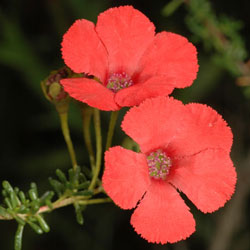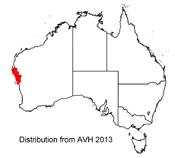Pileanthus vernicosus
 |
 |
Copper-cups
Pileanthus vernicosus F.Muell.
Pileanthus vernicosus is an erect slender woody shrub belonging to the Myrtaceae family endemic to Western Australia. Pileanthus vernicosus grows to approximately one metre tall with prominent oil glands and can live for 5–10 years. It can be found naturally in Western Australia coastal heathlands, sand dunes and plains. It extends to Geraldton in the south and as far as Carnarvon in the north of the region.
 This species is commonly known as Copper-cups in reference to its magnificent flowers, which range from red to orange and yellow. Though not a common flower in cultivation, these beautiful flowers make it perfect for gardens. Flowering occurs between September and November on twiggy branchlets densely covered in small hardy leaves.
This species is commonly known as Copper-cups in reference to its magnificent flowers, which range from red to orange and yellow. Though not a common flower in cultivation, these beautiful flowers make it perfect for gardens. Flowering occurs between September and November on twiggy branchlets densely covered in small hardy leaves.
P. vernicosus can be propagated from cuttings, seed or by grafting. Unfortunately seeds may be hard to come by and are often misidentified. If growing from seed it should be soaked for 24 hours in water before planting. Due to their shrub-like nature, grafts can be tricky to take and need a lot of extra care. In order to take a good cutting, pruning must be done after flowering in order to promote new growth.
Propagation is most successful in winter or autumn as new growth is too soft in spring. Ideally, cuttings should be taken from young plants of approximately 3–5 years of age. In the absence of these, older plants can be used however cuttings will have a reduced strike rate. Prime cuttings should be made between 50–100mm in length. However if a prime stem looks as though it will wilt then it should not be taken.
A low-strength rooting hormone can be applied to each cutting before adding to a mix of perlite and coir with high air fill porosity. Young cuttings should be kept in a room with a temperature range in the low 20s degrees Celsius and approximately 75% humidity. A hot water system or heat mats can also be used in order to promote root growth. Watering sparingly once every day is sufficient. Ensure that dead foliage is also removed.
Due to the plant's need for a well-drained soil, planting in pots is recommended. A native plant fertilizer can be used however it is not as sensitive to phosphorus and nitrogen as other Australian natives. Each plant should be repotted every 1–2 years or when leaves start to yellow due to insufficient nutrients. Plants are known to be hardy, surviving frosts and low water levels. Although P.vernicosus prefers a well lit sunny location it can handle minimum shade. Be careful not to over-water during winter as plants can be susceptible to powdery mildew.
Gemma Bach, Botanical Intern 2013
Name meaning: Pileanthus vernicosusPileanthus - from the Latin ‘pileus’, meaning a close-fitting brimless cap, and 'anthus', meaning flower. The name refers to the cap-like bracteoles that cover the developing floral buds. vernicosus - from the Latin for varnished, probably referring to the glossy oily coating of the young floral buds. |
References:
Keighery, G.J., (2002) A review of the genus Pileanthus (Myrtaceae). Nuytsia 15(1): 42, figs.
McAuliffe, J. (2013) (Pers. comm.) Australian National Botanic Gardens.
![An Australian Government Initiative [logo]](/images/austgovt_brown_90px.gif)

